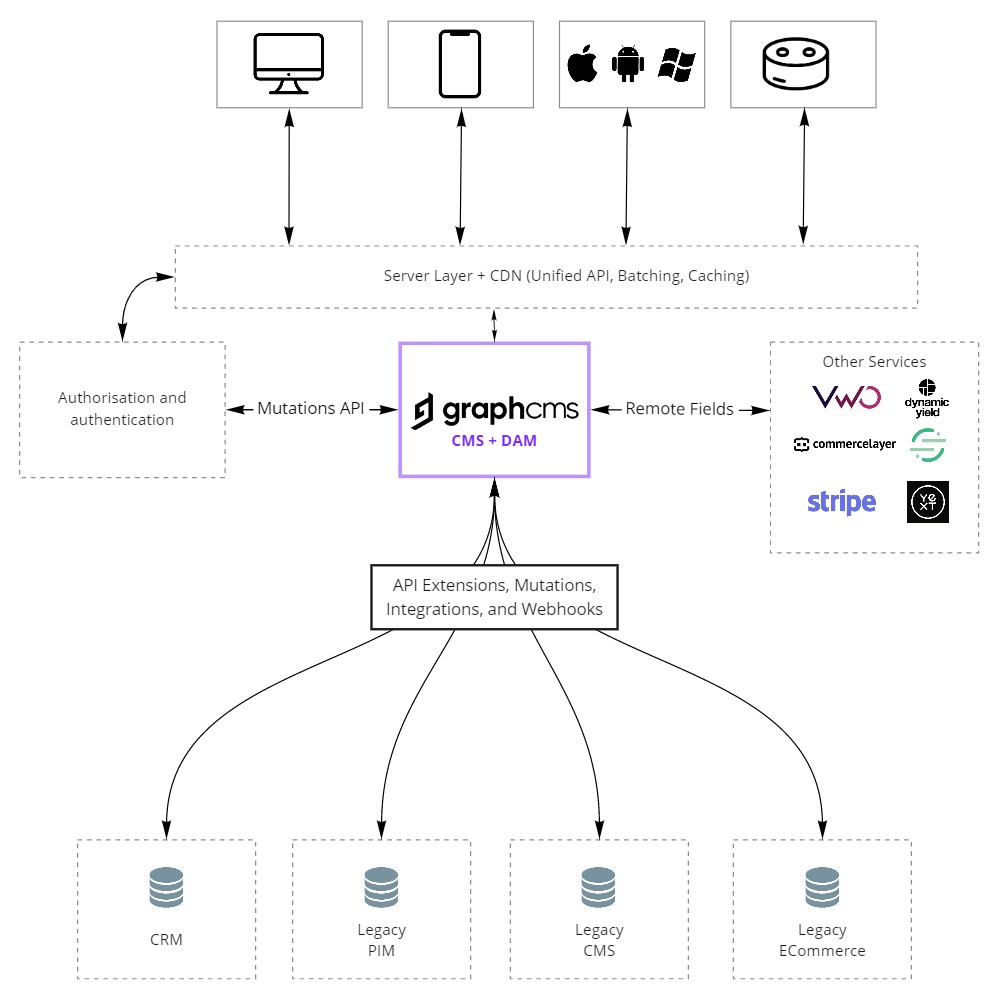As content becomes more commoditized, and the value of high-quality original content increases, businesses will need cost-effective infrastructure and quickly deployable solutions to scale their growth while actively engaging and staying relevant to their customers.
We’re big fans of applying scalable solutions to help modernize legacy or monolithic architectures. When working with a tech stack that’s weathered the years, cracks begin to show. Your tech stack is not scalable, inflexible, highly customized, and cannot be expanded. The high effort of maintenance and costs of overheads are stopping your teams from working on valuable tasks that support your business goals.
While it's naive to assume that years of business operations and software usage can just be “re-platformed” into a modern solution overnight - there are considerable risks in not gradually embracing a relevant form of modernization to stay competitive.
#Understanding Fragmented Content
A common scenario in larger organizations is the prevalence of “content silos”, or fragmented content - where several tools and services house business-critical content and information, somehow stitched together via custom workarounds. Time matters when you’re delivering content at an ambitious scale, and fragmented content causes “content chaos” across multiple repositories, slowing you down from digitizing at the pace your business demands.
However, simply “re-platforming” your stack into a modern one carries its own set of challenges and risks - there are the considerable overhauls to infrastructure and training, as well as setting up new workflows, training, and safety nets in place to ensure that the stack is able to work at parity first, and then outperform later. The solution to overcoming these challenges of fragmented content isn’t simply to replace your stack, not right away at least, but to enhance it.
A common way of doing this is by “aggregating” or federating your content into a singular Content Hub to gain a single source of truth across all content siloes. Doing so allows your teams to start working with Structured Content, providing your teams with a central repository to create, enrich, deliver, and consume content, that lets you focus on growing your business model, not maintaining it.
#Eliminating Content Fragmentation
The journey from a fragmented content landscape to a federation of content is one that requires some consideration and planning - and when done right - enables better developer efficiency and team collaboration when setting out to deliver digital experiences.
In an article for Martin Fowler, Zhamak Dehghani breaks down the steps needed on how to break down a monolithic architecture, critical when moving to a microservice-first approach, into 8 distinct steps:
- Warm Up with a Simple and Fairly Decoupled Capability
- Minimize Dependency Back to the Monolith
- Split Sticky Capabilities Early
- Decouple Vertically and Release the Data Early
- Decouple What is Important to the Business and Changes Frequently
- Decouple Capability and not Code
- Go Macro First, then Micro
- Migrate in Atomic Evolutionary Steps
With content federation, a headless CMS can easily be linked to existing monolith databases while they are still relevant to pull the relevant information from the old monolith, prolonging its life and allowing teams to refine their toolset before cutting themselves off entirely. But what do some of these microservices look like when linked together to build a digital product? Using a (very oversimplified) example of an eCommerce site, in a monolith approach there would be a single provider offering:
- A CMS to manage the content, potentially in several languages
- A shopping cart to handle user purchases
- A payment gateway to handle transactions
- An authentication service to handle user accounts and login status
- A CRM functionality to send offers and order confirmations
- A PIM to handle the products, stock inventory, and product information
- A DAM to handle promotional images and product images
Using Hygraph as a content hub allows you to focus on what you do best - running your organization and team. Hygraph connects with your existing stacks via API so you don't have to stress about overhauling your entire infrastructure and going overboard on your budgets. Here is an example to show how Hygraph lets you bring your favorite APIs to the party, as well as retain the services that are fundamental to you when going ahead with the DXP approach.
The best way to gauge the application of breaking fragmented content for you is to start gathering insights on pain points with audience engagements and associated operational costs. Once you've conducted an internal assessment on solutions that could help, such as a modular DXP approach, it's important to create a comprehensive checklist that factors in all the associated benefits, risks, and considerations that come with a change in tech stacks. Finally, when the time to modernize arises, you are better prepared to understand what steps need to be taken and are well informed of the changes required.
Interested in learning more about Working with a Content Hub or implementing a Modular approach to digital experiences with Hygraph? Let’s Talk.
Blog Authors
